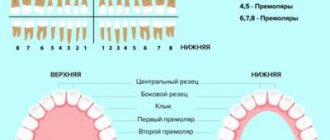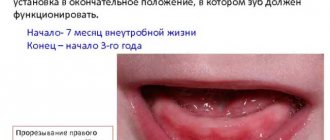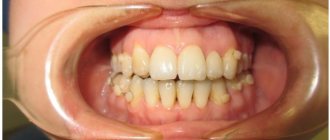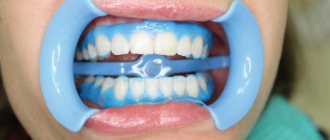- Crooked teeth
- The appearance of a second row of teeth in the jaw
- When permanent teeth do not appear for a long time
- How to distinguish baby teeth from permanent ones?
The complex process of replacing baby teeth with permanent ones is often painful and accompanied by a number of problems. The most common of them is malocclusion. The second most common problem is the appearance of a second set of teeth. Also, many parents are faced with the fact that their child’s molars and incisors do not appear for a very long time.
Crooked teeth
If permanent teeth begin to grow unevenly, you need to come for a consultation with an orthodontist at the A-Medic Network of Medical Clinics as soon as possible. The sooner such a decision is made, the easier it will be for the dentist to correct their growth. An incorrect bite is not only inconvenient, it can lead to the development of a number of diseases, for example, caries, stomach diseases, and cause childhood and teenage complexes and psychological problems.
The easiest way to straighten your jaw is to wear braces. It is very important for parents, together with the attending physician, to explain to the child that temporary inconveniences when using braces are justified and will bring invaluable benefits in the future. You need to take good care of it, because it will stay in your mouth for at least six months. This design will work most effectively during adolescence. Small children can more easily tolerate plates or trainers, which look something like boxing mouthguards, rather than braces. Children's enamel is quite delicate, so trainers that do not damage it will be the best way to correct a child's malocclusion.
Is late teething dangerous?
In addition to parents who consider late teething a warning sign, there are others who tend to believe that the later baby teeth appear, the healthier they will be. This is a common myth that has not been supported by science, so you should not believe it.
Too early or late teething or their appearance in an atypical order (outside the pattern) is a reason to see a doctor. Most likely, a diagnosis will be prescribed that will help identify the cause of this developmental feature.
The danger of late teething lies only in possible diseases that occur unnoticed by parents. If experts find out that the reasons for late teething are related to heredity, lack of calcium or vitamin D, there is nothing dangerous about it. In this case, tooth growth is stimulated by changing the diet or prescribing vitamin complexes.
The main thing is for parents to contact a specialist in time to identify a possible disease and treat it as soon as possible.
The appearance of a second row of teeth in the jaw
Each canine, incisor and molar has its own place, but sometimes a child's permanent teeth begin to form a second row. This often happens when the milky ones have not yet fallen out, but the radical ones have already begun to appear. An undeveloped jaw that provides too little room for growth can also be a source of the problem. The third reason is that the incisors and canines in the second row are “superfluous”, or supernumerary.
The second row of teeth is not only inconvenient, but also unsightly, so the problem needs to be solved. A baby tooth that does not fall out in time can be removed in the clinic. If the reason for the formation of the second row is underdevelopment of the jaw, then the dentist can remove several teeth and install braces on the remaining ones.
Reasons for violation
There are many reasons why teeth fall out late
- Deficiency of chewing load. Modern parents try to protect their children from any difficulties, including prolonged chewing of solid food. They grind soups, meat, vegetables and even fruits in a blender - as long as the child eats. You can't do that. The chewing load should be adequate for age. Otherwise, temporary roots will be reabsorbed with a delay.
- The presence of dense scars on the gums. They are formed if, in the first year of life, the child has undergone surgery on the tissues of the oral cavity, suffered a serious injury or burn of the gums. Scars are formed by very dense connective tissue. Because of this, the process of changing the bite may not proceed correctly.
- Incomplete resorption of the temporary root. This is not a pathological condition, but a physiological feature. But you need to understand that if a tooth is removed at the wrong time, its replacement will erupt in an atypical place. This may be a reason to wear braces in the future.
- Dystopia. A situation where the root rudiment was located in a non-standard place for it. Why this happened cannot be said. Doctors explain the problem by the uniqueness of a particular child’s body. The dentist decides what to do in such a situation after examining the x-rays. In some cases, it is possible to “pull” the crooked unit into the correct position. If this is not possible, you need to constantly monitor the crooked tooth, as it may pose a danger to its neighbors (put pressure on their crown or roots).
My parents won’t be able to figure out on their own why the tooth came out but the baby tooth hasn’t fallen out yet. Therefore, amateur performance is unacceptable. The smartest thing to do is make an appointment with a doctor.
When permanent teeth do not appear for a long time
The absence of permanent teeth for too long can be due to several reasons: these are the genetic characteristics of the body, their immaturity, and the destruction of tooth germs by some kind of infection.
Only a dentist can determine the true cause. At the A-Medic Network of Medical Clinics clinic, they will take a picture of the jaw, which will show how the child’s permanent teeth are formed. Sometimes they can grow inside the gums. If nothing is visible on the image, the doctor may suggest solving the problem by installing dentures.
The order of eruption of permanent teeth
At the age of 5-6 years, the replacement of baby teeth with permanent teeth begins.
This is preceded by the growth of the rudiments of permanent teeth and the physiological resorption of the roots of milk teeth. As the roots of the teeth are reabsorbed, mobility of these teeth appears. Children often swing their baby teeth on their own. The first permanent molars behind the last primary tooth (deciduous molar) are usually the first to erupt. Their appearance often goes unnoticed: the teeth erupt behind the milk teeth and their appearance is not accompanied by the loss of milk teeth. Closer to 6 years of age, permanent incisors replace primary incisors. First, the primary incisors on the lower jaw are replaced, and then on the upper jaw. At 7 - 8 years old, permanent lateral incisors begin to erupt on the lower jaw, and at 8 - 9 years old - on the upper jaw.
The formation of the roots of young permanent teeth is completed by 10–11 years.
How to distinguish baby teeth from permanent ones?
Both molars and baby teeth have a similar structure, but have a number of external differences.
- Thus, milk ones are on average lighter and whiter than permanent ones, which are distinguished by a yellowish enamel tone.
- On average, a molar is larger than its primary tooth.
- Permanent ones have a thicker layer of hard tissue and a less developed pulp.
- Dairy varieties have thinner and shorter roots.
It is important for all parents to remember that both baby and permanent teeth of children must be protected, and any problems that arise in their growth and development must be resolved immediately. Specialists from the “A-Medic” network of medical clinics can help them with this.
A few facts about teething in children
Many parents, even before the baby is born, try to find out everything about what awaits them: they read when the baby starts talking, when he should try to crawl, how to determine that his teeth are about to come through. But nature is generous with surprises, so sometimes things don’t happen as they say in the books.
If the upper teeth erupt first, this is not an anomaly
For example, the lower incisors are not always the first to erupt, although this is exactly what happens for the majority. Some children acquire their upper lateral incisors first. This is part of the norm, so there is no need to panic about it.
Another interesting fact: teething is not a very pleasant process for a baby, which is why he becomes whiny and restless.
Many parents, wanting to help the baby, run to the pharmacy for products containing ice caine. This is a grave mistake, and it can not only not improve the child’s well-being, but also make the situation worse. The use of such products in infancy is unacceptable, but special safe gels for gums will be very useful.
In addition, the child will feel better if mom or dad rocks him in their arms for a while, plays with him, and calms him down.
Many parents naively believe that the more often they examine the child’s gums and emerging teeth, the better. In fact, you shouldn’t put your hands in your baby’s mouth every hour: inflammatory gums are a magnet for infections that parents can personally transmit to the baby. One touch a day before bed or in the morning is enough. Before doing this, be sure to wash your hands with soap, and if mom’s nails are covered with gel polish or extensions, dad should do this.
Treatment of primary teeth should not be neglected, as they affect the development of molars.
Finally, most parents believe that baby teeth do not need to be treated: permanent ones will replace them anyway. Baby teeth can and should be treated without fail, since any disease (for example, caries) can penetrate the bone tissue and affect permanent teeth that have not even appeared yet. And if, due to lack of treatment, a tooth has to be removed, problems cannot be avoided: permanent teeth may not grow, an incorrect bite may form, and neighboring teeth may grow crooked.
Consequences of a double smile
Parents should not fall into a state of panic when they see an additional “element” in the child’s mouth. Double dentition is a solvable problem. The main thing is to get an appointment with the dentist on time.
If you put off dental treatment for a long time, you may encounter:
- Impaired diction. Curved incisors and fangs interfere with the pronunciation of many sounds and make the baby’s speech unclear. Correcting sound pronunciation takes a lot of time and requires qualified help from a speech therapist.
- Difficulties in chewing food. The patient is uncomfortable biting into hard foods. In the process of chewing them, small food debris gets clogged into the spaces between the “shark neighbors.” This causes severe discomfort. Cleaning between teeth takes time and effort. Small children cannot carry out this hygienic procedure at the proper level on their own. This means that the risk of tooth decay increases dramatically.
- Diseases of the gastrointestinal tract. Having difficulty biting and chewing food, some children begin to swallow food almost entirely. As a result, the load placed on the gastrointestinal tract increases. Gastritis or other gastric pathologies may develop.
- Weight loss. The complication is also the result of improper chewing of food. The child swallows large pieces and large amounts of air. Because of this, it becomes saturated ahead of time. This has a negative impact on weight gain.
- Inflammation of the gums. It is difficult to clean the interdental area from food debris and plaque as efficiently as possible. Accumulations of food put pressure on the gums and irritate them. The inflammatory process is aggravated by pathogenic microorganisms that actively multiply in plaque.
All these consequences of a “shark” smile are unpleasant and pose a health threat. Therefore, it is unacceptable to ignore the presence of a dental problem in a child.
How can you help your baby?
The main question, what to do if a child has no teeth at 8 months, requires an immediate solution. Therefore, the recommendations in such a situation are clear:
- never cause mechanical damage to the gums yourself;
- Chewing can be stimulated using a special device;
- review the baby’s nutritional issues by discussing them with the pediatrician;
- up to 11-12 months you can monitor the situation - nothing bad happens in the child’s body;
- If there are still no teeth, then you need to see a dentist.
What can a doctor do? Despite the child’s infancy, the doctor will prescribe an x-ray of the jaws. This will help diagnose edentia. In any case, you should always strictly follow the recommendations of the pediatric dentist, who will always try to help the baby.











